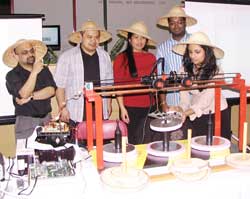Crowning achievement

Engineering students (l to r) Joseph Ajay Philip, Phana Thac, Emalinda Tolentino, Shathies Atputharjah and Josey Kochuparampil demonstrate their Hanoibot. The machine, built under the supervision of PhD candidate and part-time faculty member David Claveau and technician Ted Obuchowicz. The project addressed the Towers of Hanoi puzzle with a recursive algorithm in mechanical, instead of software, form.
dmitry rozhdestvenskiy
Computer screens displaying 3D plans, wind turbines, vehicles, a smoked meat slicer and a dog waste composter all vied for attention as people crowded the library building atrium during the third official presentation of capstone projects.
Those who arrived for a different session may have seen a hybrid electric drive train for city buses, equipment capable of automatic speech recognition, an automatic air purifier or a way to test electromagnetic interference risk for medical equipment.
Fourth-year Engineering students across the eight faculty programs presented the results of two terms of reflection and work on a problem posed last September. The results are under the scrutiny of faculty, CEGEP students invited to learn what engineering has to offer, family and friends, and, of course, other students.
“Like everyone, students perform better when they are going to present their work in public,” explained William Lynch, Associate Dean of Undergraduate Programs and Student Affairs.
All engineering students are required to take the course in their final year. By the end of September, they have divided into groups, each one addressing a particular problem. In some cases, it may be a problem their professor devised; in other cases it may be a problem presented by a local industry. The students themselves may identify a problem they would like to tackle.
“They have a series of preliminary milestones: defining the problem in a paragraph, developing a proposal with details of how to address it, and submitting progress reports,” said Lynch. Although each department may address the project a little differently, the result is the same. “This is the crowning achievement, the capstone of their undergraduate education.”
Students have to be able to handle the pressure, as a team. “It becomes a big part of their lives. The closer they are to deadline, the harder they’re working.”
Each team works under the supervision of a professor. “It’s meant to mirror a real world engineering problem,” Lynch said. In that context, the supervisor plays the role of “intelligent client.” Lynch explained that students keep in touch with their supervisor to clarify expectations or needs. “But the main role is for the supervisor to give them the problem and let them find their way.”
The course has existed in its present form since 2001. Currently, it is being adapted in a modified form for third year students. Software engineering has already developed a course with a specific, defined problem that the whole class tackles over a single term.
Other departments are in the process of establishing similar courses. “We’re satisfied with the capstone model,” Lynch said.